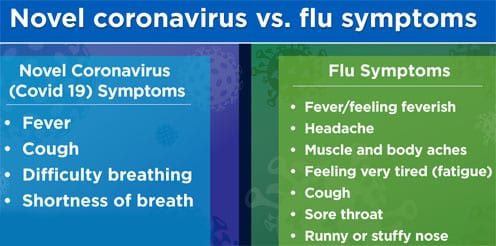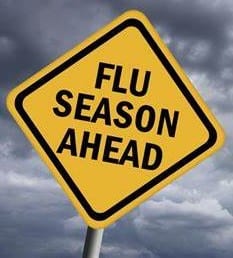What is the Corona Virus?
Blue indicates link
The coronavirus is a type of common virus that can infect your nose, sinuses, or upper throat. They can spread much like cold viruses. Almost everyone gets a coronavirus infection at least once in their life, most likely as a young child.

Most coronaviruses are not dangerous, but some are. Those that cause Middle East respiratory syndrome (MERS) or severe acute respiratory syndrome (SARS ) can be deadly.
Coronaviruses are a family of viruses known for containing strains that cause potentially deadly diseases in mammals and birds. In humans, they’re typically spread via airborne droplets of fluid produced by infected individuals.
The Flu
Influenza, commonly known as the “flu,” is an extremely contagious respiratory illness caused by influenza A or B viruses. Flu appears most frequently in winter and early spring. The flu virus attacks the body by spreading through the upper and/or lower respiratory tract.
The similarities between the coronaviruses and the flu virus as looked at under a microscope are very similar.
Serious outcomes of flu infection can result in hospitalization or death. Some people, such as older people, young children, and people with certain health conditions, are at high risk of serious flu complications. There are two main types of influenza (flu) viruses: Types A and B. The influenza A and B viruses that routinely spread in people (human influenza viruses) are responsible for seasonal flu epidemics each year.
Coronavirus and the Flu

Each year, from around October through May, international health coverage is primarily focused on the flu—and with good reason: The flu is notoriously infectious and can cause up to 45 million illnesses each year, according to the Centers for Disease Control and Prevention. But this year, the new coronavirus outbreak (aka, COVID-19) is dominating the headlines, causing hundreds of thousands of Americans to fall ill since the start of the outbreak. Both viruses—influenza and coronavirus—are highly infectious diseases with similar symptoms, transmission, and prevention methods, but is one necessarily worse than the other? Here, infectious disease experts across the US compare all aspects of both illnesses, to determine whether coronavirus is any worse than the flu—or vice-versa.
Flu Symptoms
Both seasonal flu viruses (which include influenza A and influenza B viruses) and COVID-19 are contagious viruses that cause respiratory illness. According to the CDC, the flu typically manifests itself in symptoms such as fever, cough, sore throat, muscle aches, headaches, runny or stuffy nose, fatigue, and occasionally, vomiting and diarrhea—typically, the latter two are more common in children.
Those flu symptoms often come on suddenly after an incubation period of two to five days. While the majority of people infected with the flu will be fully recovered in about two weeks, for some people (most often those with compromised immune systems), the flu can lead to complications like pneumonia. According to recent data from the CDC, this year just 1% of people suffering from the flu have been hospitalized.
Coronavirus Symptoms
The CDC describes a wide range of symptoms, such as fever; cough; shortness of breath or difficulty breathing; chills or shaking with chills; muscle pain; headache; sore throat; and loss of taste or smell, coming on two to 14 days after exposure to the virus. One study, involving just 100 people with the virus, published January 30 in The Lancet, noted that the most common symptoms were fever, cough, and shortness of breath, with approximately 5% reporting sore throat and runny nose, and just 1-2% reporting diarrhea, nausea, and vomiting.
Caution
The symptoms between the coronavirus and the flu are very similar and it is very necessary for the proper diagnosis. Covid-19 is one of many coronaviruses.
The disease caused by the new coronavirus that’s sickened more than 42,000 people in China now has an official name: COVID-19. It stands for the coronavirus disease that was discovered in 2019.
The World Health Organization announced the name Tuesday, saying it was careful to find a name without stigma.
There are many different kinds of coronaviruses. Some cause mild illnesses, such as the common cold.
In December 2019, people only knew of the novel coronavirus as an emerging outbreak. Three months later, the world is in full pandemic mode, buckling down for self-imposed social distancing across the U.S. and around the globe.
In March 2020 this coronavirus was called COVID and officially declared a pandemic by, “The World Health Organization”(WHO).
Why so many people had to die before social distancing and other measures were taken still leaves a question mark in my mind.
CO stands for corona, VI is for the virus, and D is for disease, the CDC says. Tedros Adhanom Ghebreyesus, Ph.D., director-general of the WHO.
Controlling the Flu
Each winter, millions of people suffer from seasonal flu. Flu—the short name for influenza—is caused by viruses. Viruses are very small germs. Some viruses can spread easily from one person to another. They cause illnesses or infections like the flu.
Flu is a mild illness for some people. For older people, especially those who have health problems like diabetes or heart disease, the flu can be very serious, even life-threatening.
The flu is contagious—that means it spreads from person to person, often through the air. You can pass on the infection before you feel sick. You are contagious for several days after you get sick. You can catch the flu when someone near you coughs or sneezes. Or, if you touch something the virus is on, like Ellen and Jack’s phone or doorknob, and then touch your nose or mouth, you could catch the flu.
The flu virus can live on a surface like a book or a doorknob for a number of hours.
Remember to wash your hands often when you are around someone who is sick. Make a point of washing them before eating or touching your eyes, nose, or mouth. If you can, stay away from sick people. That will help stop the flu from spreading.
Preventing The Flu, Vaccinations

The most effective way to prevent influenza is by getting the influenza vaccine (the flu shot or nasal spray) and using simple infection control measures such as handwashing. Antiviral medicines can also help prevent infection if you are exposed to the flu.
Right now we are heading into flu season. There are controversies about vaccinations, but it is the only protection there is. The similarities between COVID-19 and flu/influenza are very similar. The big problem is there are no approved vaccinations against COVID-19. All we can do is follow the methods that are out there. Social distancing, face masks, and so on.
Any symptoms of the flu should not be taken for granted and you should consult with a doctor for your health safety.
Thank you for reading
Michael
Comments are welcome